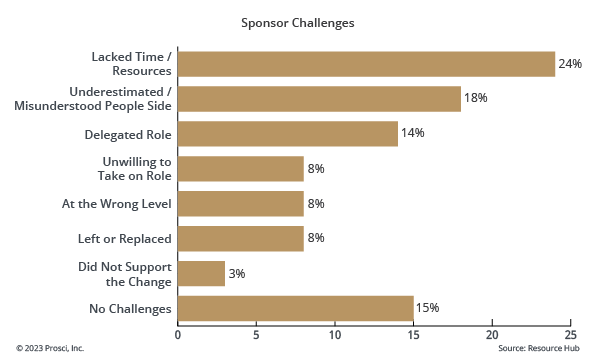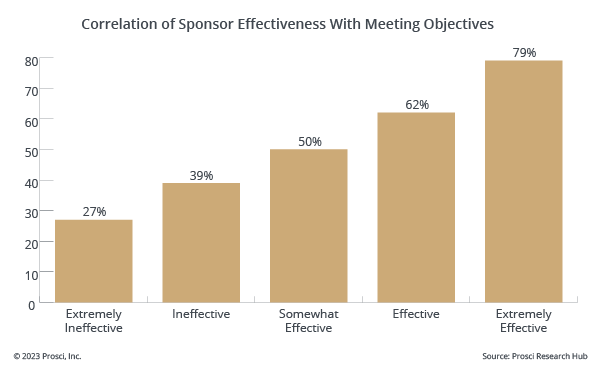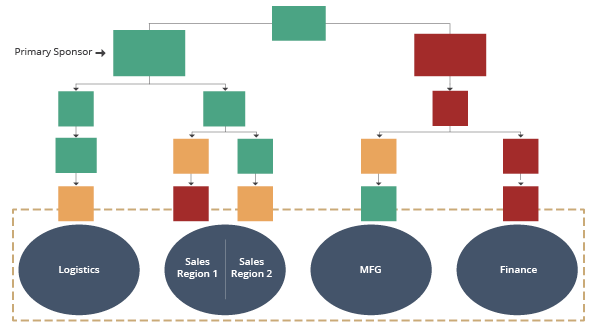5 Ways to Help Sponsors Build a Coalition of Support for Change
3 Mins
Updated: August 5, 2024
Published: May 11, 2022

One of the key roles of sponsors during any change is to build a coalition of support among important stakeholders in the organization. With such a coalition, organizational changes are far more likely to succeed. Yet, sponsors often fail to demonstrate support for the project in words and actions. Here’s how you can help your primary sponsor build the coalition of support your project changes need for success.
The ABC's of Effective Sponsorship
When managing change, practitioners depend on executive leaders to perform the ABCs—an acronym for the three key roles a sponsor must perform to be an effective leader of change. A sponsor must be Active and visible throughout the life of the project, Build a coalition of support, and Communicate directly with employees.
Of these critical activities, building a coalition of support can elude even the most well-intentioned sponsors. In the twelfth edition of Prosci's Best Practices in Change Management benchmarking research report, 36% of respondents say it's the role sponsors struggle most to fulfill during change.
Why? The most common reason is that sponsors don’t understand their role. In the study, project teams report that half their sponsors have no understanding or only some understanding of their role in managing the people side of the change. And 18% of participants report that their sponsor underestimated or misunderstood the people-side impacts of a project. It stands to reason that only 33% of respondents found their sponsors effective or highly effective at building a coalition of support.

Effective Sponsor Coalitions
Although some changes are small enough that a single sponsor will suffice, most organizational changes impact multiple business groups and require multiple sponsors. This sponsor coalition consists of the primary sponsor along with other sponsors throughout the organization, who support changes by conducting key activities within their respective groups.
Prosci research shows that effective sponsor coalitions:
- Engage across the organization
- Create, coach and maintain a network of active and committed change agents
- Communicate the importance of role-modeling the change, and encourage senior leaders to participate and support the change
- Cultivate management support of the project
- Ensure alignment of expectations among people managers
- Clarify roles
- Solicit and openly receive management feedback
Your goal as a practitioner is to enable sponsors as they enlist peers, help these peers understand why they must advocate or “role model” the change for employees, and ensure that peers follow through on the commitment. As change enablers, you and the change team provide coaching and guidance, and work with sponsors to facilitate key activities and actions as needed.
Why Build a Sponsor Coalition?
When sponsors fail to lead by example, promote or champion the change adequately, or otherwise “walk the talk” for successful change, they can negatively impact a project’s chances for success. Bottom line, people generally won’t commit to a change to any greater extent than the sponsor does. And Prosci research consistently shows that projects with an extremely effective sponsor meet or exceed objectives nearly three times as often as projects with a very ineffective sponsor. 
5 Ways To Help Your Sponsor Build a Coalition
There are many paths to building an effective coalition, depending on the change and your organization’s needs. The key is to ensure that sponsors are well informed and equipped to gain commitment from peers and stakeholders. Here are five tips for building a coalition of support.
1. Present a compelling case for the change
Executives and managers value facts, data and outcomes. You make their job easier by equipping them with the right information and research to make a compelling case for change with colleagues. Such information includes benefits of success, reduced likelihood of resistance, and risks of not changing.
2. Use tailored and plain language
Leaders are often unfamiliar with change management terms. Your words will resonate when you communicate in plain-spoken terms and tailor the conversation to the specific areas of the organization that will experience the change.
3. Build out a Sponsor Coalition Map
Analyzing sponsor commitment and alignment across the organization helps you and your sponsor drive the Awareness, Desire and Reinforcement elements of the ADKAR Model. Diagramming this in an organizational chart enables you to visualize the level of support you have for a change in each business group, analyze the overall health of the coalition, pinpoint required actions, and identify risks to your change effort.
 Prosci Sponsor Coalition Map
Prosci Sponsor Coalition Map
4. Equip sponsors and change agents
Most sponsors have Awareness of the importance of their role and the Desire to be an effective sponsor. However, few have received opportunities to develop their Knowledge of what effective sponsors actually do. Hosting a Change Management Sponsor Briefing addresses this issue by clearly connecting change management to business success and detailing the sponsor’s critical role in enabling that success with support from stakeholders. Once you establish this baseline understanding, you can implement biweekly meetings with sponsors and coalition members to share updates, clarify confusion and remove roadblocks.
5. Coach sponsors
Periodic, one-on-one coaching sessions help sponsors translate their Knowledge into Ability. Change teams can also enlist effective sponsors to coach new or less effective sponsors in change management.
Leading Change Behind the Scenes
Building a sponsor coalition is a critical aspect of the executive sponsor’s employee-facing role in change. As a practitioner, your role in that effort is to work behind the scenes—enabling the sponsor’s success through effective planning, coaching, education and skill building. Working together, you can help your primary sponsor demonstrate meaningful support for the change in both words and deeds while building an effective coalition of support for the change across your organization. 
![]()

